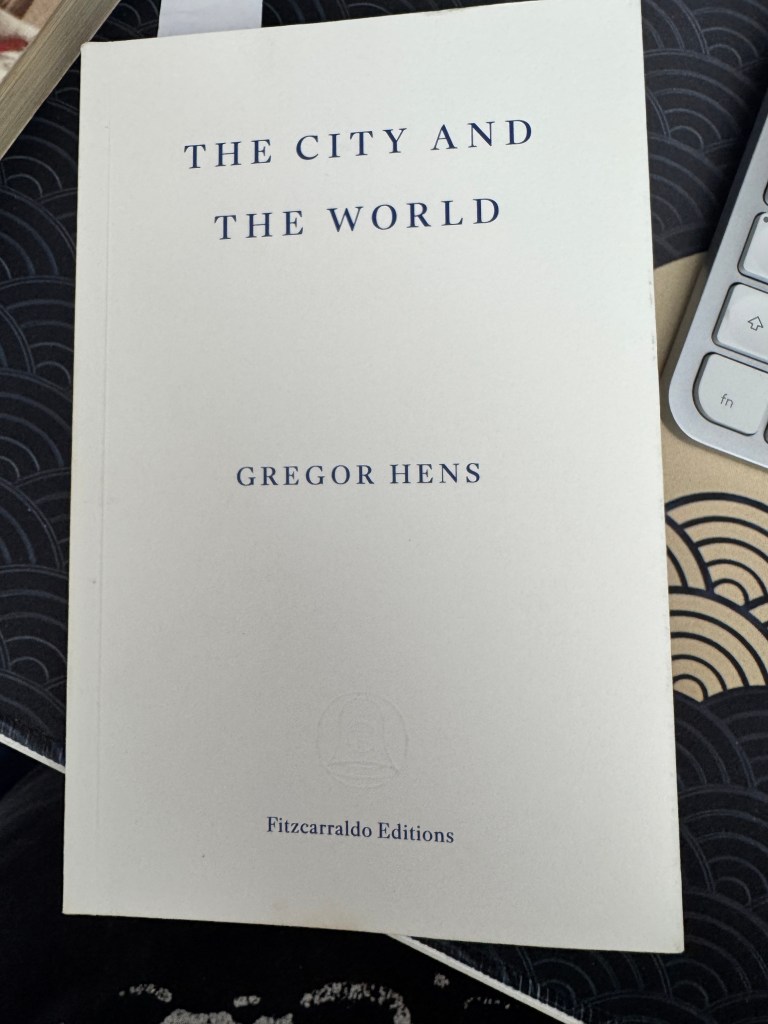
The City and the World by Gregor Hens
German non-fiction
Original title – Die Stadt und der Erdkreis
Translator Jen Calleja
Source – Personal Copy
One of the first prose works from Fitzcarraldo, I fell in love with an earlier work by Gregor Hens, Nicotine. I had not long stopped smoking when the book came out ten years ago. Gregor had also been stopped a couple of years, and yes, ten years later, I am still stopped smoking, so when I saw this was coming out, I knew I would love it. Apart from that, he has also translated Will Self’s recent books into German. The book is one of those that is hard to pigeonhole. Still, the main thread of the book is our relationship with the city now, and also how we navigate the modern cityscape, in a way, revealing the similarities between many cities.
In January 1976, a year and a few months after Pere’s experiment, Peter Handke made his own observations in Paris; he carried out a far more spiritual kind of walk-ing, standing, sitting. His gaze is not that of a stationary camera mounted on the tripod of a café table, but that of the angel Damiel, who in Wim Wenders’ Wings of Desire is trying to get closer to people, the city dwellers, and not least the patrons of the reading room in which I am writing these lines, than his nature allows.
Handke sees the passers-by in the square ‘in a flickering winter atmosphere, notices a woman’s fake fur flying in the wind and notes: They are living before the catastrophe.’ Which one? What catastrophe has Paris been spared so far? What catastrophe are we (my mother, my brother, and I) facing? Handke was right, he had to be right, because we are all always living on the verge of catastrophe. One or another.
The mention of Wim Wenders and his film
Now, the book is a rambling look at his view of the city he has visited, but also about those writers, thinkers, and architects who have shaped those cities, both in the way they are laid out and within our minds. He takes us from Latin America and Buenos Aires and its connection to post war Nazi activities and then through China. Even flying cities and that writer on cities. Here, of course, he mentions Self, a great fan of psychogeography and people like Guy Debord, who, of course, coined the term and his map of the little islands of Paris. I loved the other parts, a mention of Berlin and Wim Wenders filming his masterpiece, The Wings of Desire ( I am such a fan of this film, I have watched it tens of times ). Another vague connection is a tale around the lead singer of Einsturzende Neubauten, Blixa Bargeld, which made me smile as I had recently just bought a couple of the band’s CDs. Another writer he mentions is Alexander Kluge, and his book Air Raid, which recounts the destruction of the small city where he grew up during World War II. I have reviewed this book.
Alexander Kluge recognizes that the air raid ordered by Harris on his hometown of Halberstadt in April 1945 is a hyperobject, an elusive, temporally and spatially diffuse entity. The dimensionality of the situation can only be represented in a literary montage that links the strategy from above with the strategy from below. In his book on the events, Kluge uses everything from eyewitness reports and interviews with pilots to maps and graphics, everything that could shed a light on the complex system of space and time, because the bombing does not begin with the air raid siren, with the development of weapons, nor does it end with residents scratching around for the remains of their relatives and friends in cellars that have become ovens in the firestorm because of the adjoining coal stores. If it ever ended at all, it was probably with Kluge’s final report written in 1970, which can, however, only ever be a temporary one.
I ;liked this last line of this piece about Kluge’s Air raid
It is fair to say I would love this book, it fits nicely next to the likes of Kluge, Sebald and Ester Kinsky, all of which are mentioned in the book at some point. It is one of those drifting books, a one-person quest to answer how we came to the cities we have. Also, if you’re a fan of Psychogeography and films like Robinson in space/ It is a book that I will return to over time it has so many little vignettes and titbits of information it needs to be read and read over time it is a book that will leave you wanting to look at a big city differently next time you visit. A perfect example of what the white Fitzcarraldo books are is thought pieces that make you, as a reader, think and question. A shadowplay of what a city is, as Ian Curtis said in his song Shadowplay, “to the centre of the city, where all roads are waiting for you ” they will be after you have read this book !!!
Related
Published by







